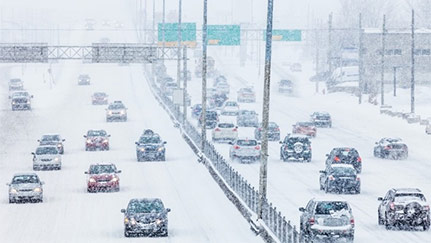Winter driving
Depending on what part of the country you are in, September through October is typically the best time to prepare your vehicles and drivers for the upcoming winter driving season.

Winterizing vehicles
Winterizing should take place at least a month before the first expected ice/snow. During this time, organizations should ensure vehicles are in proper condition and emergency supplies are in place.
Inspection and maintenance
Cold, ice and snow can put vehicles to the test. Therefore, an enhanced winterizing maintenance and inspection should take place. The winterizing should include typical scheduled maintenance activities with emphasis placed on the following:
- Changing of fluids such as proper oil, antifreeze coolant, and antifreeze-based windshield wiper fluid.
- Tires:
- Should be evaluated for proper tread, critical for driving on snow and Ice.
- Snow tires are recommended in heavy snow areas, particularly when operating in rural areas.
- At a minimum, all-season tires should be used.
- Provide chains in jurisdictions where chain laws may be in effect, if using automatic chains ensure they are working properly
- Windshield wipers should be examined and replaced with winter-grade replacements if necessary.
- Defrosters should be tested to make sure they are heating properly, and fans are operational.
- Batteries: proper voltage, terminal connections for corrosion, age – replaced if past the life expectancy.
Emergency Supplies
Being stranded in the cold is more common than one expects and can be very dangerous. Each organization should always have an emergency supply kit in each vehicle, with enhanced contents for the winter season. Winter contents should include:
- First aid kit
- Reflective triangles and reflective vest
- Extra ice scraper, long handled ice scrapers should be provided for taller vehicles
- Heavy blanket or sleeping bag, hat and gloves (encourage drivers to have extra sweatshirt or jacket)
- Flashlight with new batteries
- Several plastic bottles of water
- Non-perishable snacks and energy bars.
- Sand or kitty litter for traction*
- Shovel*
- Battery jumper cables*
- Basic tool kit (screwdrivers, pliers, knife, duct tape, etc.)*
* Some organizations choose not to include these items as they operate in urban areas where emergency and vehicle assist services are readily available and they prefer not to have staff shoveling, jumping batteries, etc.
Winterizing drivers
About a month prior to the expected first ice or snowfall is the best time to have a winter driving meeting. The meeting should be mandatory for all drivers, their managers, and others responsible for service schedules or dispatching. Core meeting topics include:
- Safety expectations
- Weather related shutting down of company vehicle travel.
- Management support for driver discretion in pulling over to find a safe place to park if conditions deteriorate.
- Preparation
- The need for drivers to carry additional emergency clothing: heavy jackets, layered garments, hats, gloves and boots
- The need for additional emergency snacks and water on long trips.
- Phone charger
- Route planning
- Allowing extra time because delays are likely.
- Checking and monitoring weather and road conditions.
- Using major roads, which are likely to better maintained.
- Safe driving tips
- Proper vehicle pre-trip inspections with special emphasis on winter items described above.
- Visibility
- Scraping all windows, mirrors, and ensuring windshield is well defrosted before leaving.
- Clearing lights, backing cameras, and safety sensors.
- Staying alert – focus on driving and no distractions.
- Following distance – increasing typical three seconds for light vehicles to five-plus seconds, depending on road surface. For larger vehicles, adding an additional two to three seconds onto the normal safe following distance.
- Maintaining open lanes to the sides to not be a casualty to another’s spinout.
- Signaling intentions early so others have more time to respond.
- Intersections
- Slowing gradually in advance so hard braking is not required.
- Ensuring cross traffic has come to a complete stop before proceeding.
- Ensuring adequate space prior to pulling out onto the roadway.
- Caution around snowplows.
- Vehicle specific characteristics:
- Not using cruise control
- Proper use of safety assist systems and anti-lock brakes
- All-wheel and four-wheel vehicles: not being over-confident
- Procedures when losing control.
- Emergency procedures when stranded.
Driver resources
Enhance your winter driving training by posting or sharing the following resources:
- Light vehicles
- Medium/heavy trucks: Winter Driving
